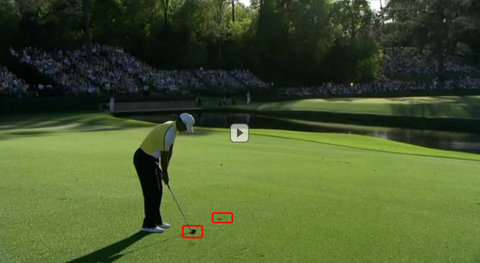The Golf Blog: Did the Rules Committee fudge rules to allow Tiger Woods to avoid DQ
The Golf Blog says: Below we break down the questionable and controversial aspects of the Rules Committee’s explanation of how Tiger Woods avoided disqualification under a special discretionary provision called Rule 33-7. Before we do, we wanted to alert new readers that we are big Tiger Woods’ fans. We’ve supported him from the start of his career–some readers may even accuse us of being on his payroll (don’t worry, we are not!). At time same time, we are reporters of golf news. We often ask questions that golf beat reporters won’t ask. We think it was fair to permit Tiger Woods to play, but we do question whether the ruling comports with the rules. The official explanation below leaves a lot unanswered.
“Yesterday afternoon, the Rules Committee was made aware of a possible Rules violation that involved a drop by Tiger Woods on the 15th hole.
“In preparation for his fifth shot, the player dropped his ball in close proximity to where he had played his third shot in apparent conformance with Rule 26. [Problem: This is a dubious finding if the standard of Rule 26-1 is “as nearly as possible at the spot from which the original ball was last played.” The standard isn’t “close proximity.” Tiger was several feet behind the original spot.]
After being prompted by a television viewer, the Rules Committee reviewed a video of the shot while he was playing the 18th hole. At that moment and based on that evidence, the Committee determined he had complied with the Rules. [Problem: What evidence? This really was the source of the rest of the problems that ensued. If the Committee watched the video, it was obvious Tiger hit the ball a few feet or yards behind his original divot. This statement calls into question the judgment or explanation of the Committee. And why didn’t the Committee ask Tiger about the drop before he signed his scorecard? That would have been the obvious and hopefully normal thing to do with a potential rules violation. The Committee could have then asked Tiger, “Where did you drop the ball on 15?” And Tiger would have said, “I dropped it 2 yards behind the original spot.” The infraction, noticeable on the video, would have been confirmed by Tiger.]
“After he signed his scorecard, and in a television interview subsequent to the round, the player stated that he played further from the point than where he had played his third shot. Such action would constitute playing from the wrong place.” [Problem: This was obvious from the video. How could the Committee miss it if it reviewed the video?]
“The subsequent information provided by the player’s interview after he had completed play warranted further review and discussion with him this morning. After meeting with the player, it was determined that he had violated Rule 26, and he was assessed a two stroke penalty. [Problem: This was obvious from the video. Why didn’t the Rules Committee catch it when it first reviewed the video?]
“The penalty of disqualification was waived by the Committee under Rule 33 as the Committee had previously reviewed the information and made its initial determination prior to the finish of the player’s round.” [Problem: Seriously? If the Committee screwed up the first ruling, come out and admit it. Rule 33-7 wasn’t meant to excuse a player’s ignorance of the rules of golf (at least that’s what USGA said in its explanation of Rule 33-7). So the Committee’s explanation is that basically the Committee made a mistake in its initial review on Friday when it had a chance to have Tiger avoid DQ and didn’t want to hold that against Tiger on Saturday. That basis sets a new precedent under Rule 33-7–Committee error can be an “exceptional individual case” warranting a waiver of disqualification. That solution seems fair. The problem remains: How did the Committee err in the first place in reviewing the video? How could it possibly think no infraction occurred if it reviewed the video as it said it did.]
— Fred Ridley, Chairman, Competition Committees
Tweet
